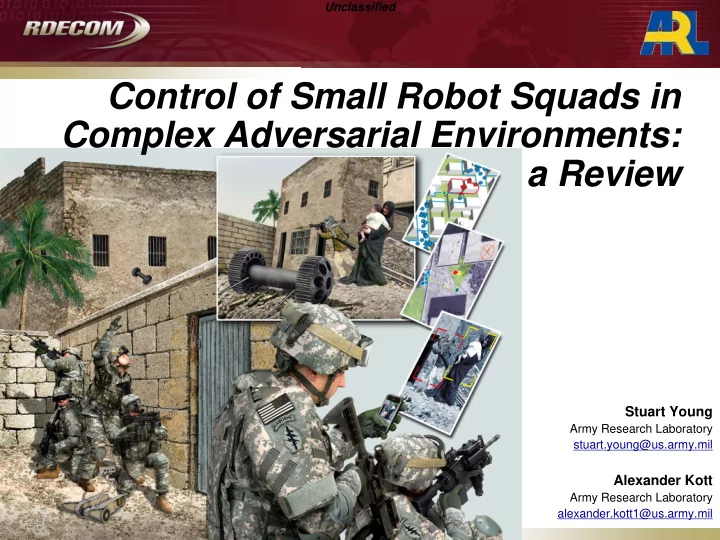

Unclassified Control of Small Robot Squads in Complex Adversarial Environments: a Review Stuart Young Army Research Laboratory stuart.young@us.army.mil Alexander Kott Army Research Laboratory alexander.kott1@us.army.mil Unclassified Unclassified
Unclassified Scope The Robotic Force: – Small military robots – Moderately sized squads – Ground combat environments The Mission: To clear and secure several three-story buildings – Normally – leave behind a squad of soldiers – Alternative – leave behind one or two UGS – Better – leave 3-5 small robots and 5-10 small stationary sensors A suitable challenge problem to the small-robot community – Ready applications in real-world operations – Combines numerous challenging technologies – Enables easy experimentation Unclassified Unclassified
Unclassified Perception LADAR – Scanning, Flash, MEMs – COTS options: • Sick LADAR • Swiss Ranger • Hokuyo URG-LX – LADAR-based collaborative mobility Vision – Stereo-imaging approach Hybrid – Integration of LADAR-based and stereo-based perception Unclassified Unclassified
Unclassified Situational Awareness Friendly: – Blue force tracking (with GPS availability) – (SLAM) for self-localization in GPS-denied environments Enemy / Non-combatant: – Acoustic and video shooter detection – Detection of humans and activities via computer vision Unclassified Unclassified
Unclassified Integration of awareness Individual platform architecture – Robotic Intelligence Kernel (RIK) – ACS (Autonomous Capabilities Suite) – Mobility Open Architecture Simulation and Tools (MOAST) 4D/RCS Collaboration across platforms – Requires combining and de-conflicting maps – In three-dimensions – Unreliable localization Integration with operator awareness – At different levels of abstraction – Before robots have built their awareness Unclassified Unclassified
Unclassified Robot communication Paradigms – Explicit comms; exchange of messages through RF • Challenge: unreliable RF links – Stigmergic comms; observing the clues left by another robot • Challenge: lack of visual contact – Combination of the two paradigms Communication languages – Should be frugally adapted for the mission • e.g. the important information may be who does what and when – Should allow a description of the area to patrol – Should communicate the planned sequence – Should communicate windows of potential contact Unclassified Unclassified
Unclassified Infrastructure for multi-robot communications Middleware • Application-agnostic, platform-agnostic • Advertises the type of service they provide • Provides automated service rediscovery Networking layer • Protects from changes in the underlying communications infrastructure • Persists in inherently unstable battlefield network environment Unclassified Unclassified
Unclassified Interacting with human controllers Paradigms for control – Sequencing or switching paradigm – Playbook paradigm – Delegating approach – Policy-based control Human controller – Fundamental differences in human and robot reasoning and representation – Operator has to continue to fight as a member of his platoon – Physical interface must take this limitation into account. – Increased autonomy reduces cognitive load Unclassified Unclassified
Unclassified Collaborative planning and decision-making Paradigms: • Hierarchical – Multi-robot: often centralized – Social analogies • Reactive – Avoids modeling and planning – Multi-robot: often decentralized – Biological analogies • Hybrid – Combination of Hierarchical and Reactive Paradigms Reactive Hybrid Hierarchical Unclassified Unclassified Small-scale robots FCS ANS
Unclassified Paradigm comparison Deliberative Advantages from C2 perspective: – Controller understands this mode of operation – Controller can supply partial or complete plan Challenges: – Centralized planning and allocation of tasks with unreliable and infrequent communications – Reacting to unexpected events – Heavy computing load on the ‘central’ robot – Subject to computational and communications lag Reactive – Emergent behaviors (ant-like) Advantages from C2 perspective: – Does not require centralized intelligent node – Requires less computational resources (important for small robots) – Allows robots to act rapidly in a changing situation or in response to sudden threats – Can operate robustly in communications-starved environments Challenges: – Can be naïve – Deceived, exploited by an intelligent adversary. – Difficult to understand and control Unclassified Unclassified
Unclassified Paradigm comparison continued Hybrid – Adds a layer of supervisory or planning component to a reactive paradigm – Less computationally expensive than deliberate – Not as naïve as reactive system – Often broken up in to basic modules (e.g. mission planner, mapping) which may be distinctly deliberative or reactive – In a multi-agent system the concurrent but independent actions lead to an emergent social behavior – Homogeneous robots: swarm approach may be applied – Heterogeneous robots: marsupial approach may be appropriate Unclassified Unclassified
Unclassified Reasoning in adversarial environment • Explicitly consider enemy actions and counteractions Attack • Use terrain to avoid detection and hostile Goal fire Predicted Threat Path Regions • Maximize chances for success in spite of intelligent efforts by the enemy Demoralized • Several papers describing this such as DARPA RAID program which is focused on computational techniques of adversarial reasoning Example: • Define likely infiltration routes into and through the building. Unclassified Unclassified
Unclassified Delivering value to the warfighter • Identify potential hazards. • Perform long-endurance surveillance • Detect human intruders and peculiar activities • Deploy small sensors in a marsupial fashion • Modify human behaviors by mere presence • Execute target designation • Carry lethal or non-lethal weapons Detractors say: – Legal implications Supporters say: – Robots can be more ethical – More compliant with Laws of War and Rules of Engagement – Can reduce collateral damage, as compared to human warriors Unclassified Unclassified
Unclassified Implications for C2 Challenging: – Difficult to adjust to differences in perception and situational awareness – Communicating the commander’s understanding of the situation is hard – Required precision and complexity can be burdensome to the human – Execution decisions may be counterintuitive – Non-human tactics to match robotic strengths and weaknesses – Complex legal and ethical issues Encouraging: – ROEs can be rapidly changed and disseminated – Re-tasking can be frequent and rapid – Coordination between robots can be more precise and minute – Can be more ethical – Can cause less collateral damage than humans Unclassified Unclassified
Recommend
More recommend